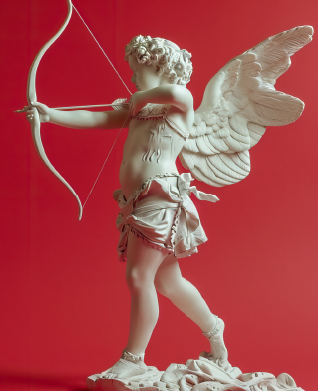What is Valentine’s Day?
The Good, The Bad, The Cherub
Much like the political divide, people either love or hate Valentine’s Day. The evidence in support of such a statement is blatantly obvious from the sentiment seen on social media. There are those who love Valentine’s Day, and those who either abstain or just don’t like it. This is especially poignant in the 21st century as there are many people who would rather just celebrate their platonic friendships than their romantic ones around this day. But this is not a new phenomenon. As an example, in decades prior, you could clearly see the divide between love and hate for February 14 in teen and twenty-something popular TV shows like Beverly Hills 90210, Melrose Place, Party of Five, and more. Whether you love or hate it, Cupid’s special day is upon us. But how exactly did this day become what it has?


To be honest, and fair, no one really knows. The genesis of Valentine’s Day has more fake news behind it than the sheer volume of UFO sightings and military drone movements over New Jersey last month. In other words, there are a lot of theories, and there is some semblance of historical evidence, but nothing that definitively tells us why Valentine’s Day was created. At least not compared to holidays like Christmas, Hannukah, Easter, etc.
So rather than wax poetically for two pages about the history of what has become known as the “Hallmark Holiday of Love,” we felt giving our readers a synopsis of come of the history, as well as today’s translation of Valentine’s Day, might be more informative, interesting, and fun.
LOVE CAN BE DEADLY
Ironically, many of the genesis stories around Valentine’s Day are based in martyrdom. And given “The Bard’s” tale of Romeo and Juliet, you can understand why some of those tales may actually be true. Bear in mind that Saint Valentine is the clear front-runner in who the day is named for given his involvement in the vast majority of legendary tales. Some of these martyrdom stories connected to February 14 include legends of the imprisonment of Saint Valentine of Rome for ministering to Christians persecuted under the Roman Empire in the third century.

To add further biblical, or holy reference to it, Saint Valentine allegedly restored sight to the blind daughter of his jailer. There are also numerous later additions to Valentine lore that have a far deeper connection to the theme of love including that tradition maintains that Saint Valentine performed weddings for Christian soldiers who were forbidden to marry in defiance of the Roman emperor, which led to Valentine’s execution. There is even an 18th-century elaboration on the legend that claims Valentine wrote his jailer’s daughter a letter signed “Your Valentine” as a farewell before his execution.
THE FEAST OF SAINT VALENTINE
They say that there is some truth to every myth or legend. Given the aforementioned lore, you can see where so many elements of Cupid’s special day come into modern day parlance, and tradition. So, let’s take a look even further into the background of how we celebrate what was once referred to as, and sometimes still is, “The Feast of Saint Valentine.
According to Wikipedia: The 8th-century Gelasian Sacramentary recorded the celebration of the Feast of Saint Valentine on February 14. The day became associated with romantic love in the 14th and 15th centuries, when notions of courtly love flourished, apparently by association with the “lovebirds” of early spring. In 18th-century England, it grew into an occasion for couples to express their love for each other by presenting flowers, offering confectionery, and sending greeting cards (known as “valentines”). Valentine’s Day symbols that are used today include the heart-shaped outline, doves, and the figure of the winged Cupid. In the 19th century, handmade cards gave way to mass-produced greetings. In Italy, Saint Valentine’s keys are given to lovers “as a romantic symbol and an invitation to unlock the giver’s heart”, as well as to children to ward off epilepsy (called Saint Valentine’s Malady).

THE MODERN VERSION,
Knowing the background of such an occasion, and at least a portion of the myths around its genesis, how do you end up with a global population so divided on a day meant to celebrate the one human emotion most spend their lives seeking – love? It’s called being human. Yes, you have people who do not care for romantic interaction in their lives and prefer to live on friendships and family alone. They usually remain agnostic with respect to our fat little cherub. And there is absolutely nothing wrong with that.
However, if you follow pop culture in any way, you will note that it is in the younger mindset of our culture that a disdain for Cupid usually comes from. And more often than not, that “hate” is driven by a recent dramatic romantic breakup. Then there are those that believe that Valentine’s Day is outdated and can be construed as misogynistic. In this writer’s humble opinion, I think the latter is taking political correctness a step too far. After all, when it comes to the battle of the sexes, love is the great equalizer. We all love in our own way, but it is love, nonetheless. The only thing that may be outdated is that fat little, often naked, cherub with a bow and arrow. While adorable on every level, maybe a more modern icon for Valentine’s Day is needed.
In other words, isn’t the point of Valentine’s Day to express and enjoy this all too powerful emotion in all of its forms? After all, there is a reason why chocolatiers, flower shops, and greeting card companies make the level of money they do around February 14: because people want to celebrate their love for one another.
And let’s not forget the centuries of drama, comedy and romance all centered around what love is: the ultimate expression of human emotion.
Happy Valentine’s Day!





